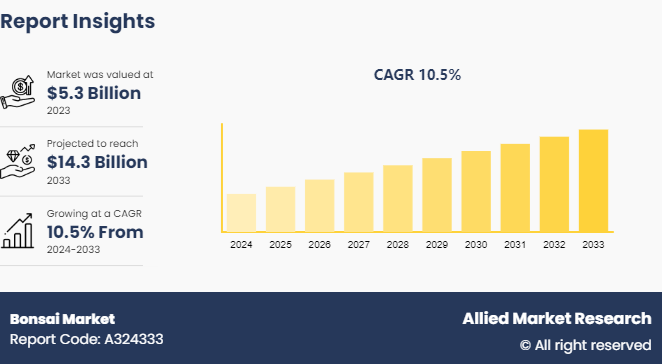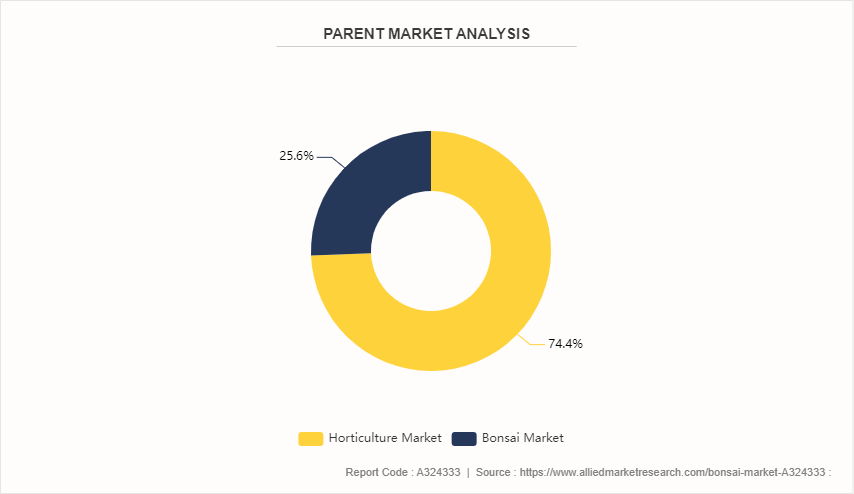Bonsai Market Research, 2033
Market Introduction and Definition
The global bonsai market size was valued at $5.3 billion in 2023, and is projected to reach $14.3 billion by 2033, growing at a CAGR of 10.5% from 2024 to 2033.
Bonsai’s are little trees grown in pots and carefully shaped them to resemble the shape and size of mature trees. Bonsai originated in China and gained popularity in Japan, emphasizing beauty, balance, and harmony with nature by combining artistic expression with horticultural knowledge. The bonsai market offers many tree species, specialty equipment, soils, pots, and accessories. Key players include major retail chains, online merchants, and small-scale craftsmen. The market serves plant collectors, professional landscapers, and hobbyists. A growing interest in sustainable living and new gardening techniques drives the product demand. In addition, the visual appeal and cultural value of bonsai add to its attractiveness in the market, creating a broad and growing global market.

Key Takeaways
- The bonsai market study covers 20 countries. The research includes a segment analysis of each country in terms of value for the projected period.
- More than 1, 500 product literature, industry releases, annual reports, and other such documents of major bonsai industry participants along with authentic industry journals, trade associations' releases, and government websites have been reviewed for generating high-value industry insights.
- The study integrated high-quality data, professional opinions and analysis, and critical independent perspectives. The research approach is intended to provide a balanced view of global markets and to assist stakeholders in making educated decisions in order to achieve their most ambitious growth objectives.
Key Market Dynamics
Rise in interest in gardening and sustainable living on a global level are main factors driving the bonsai market growth. People are looking for methods to re-establish a connection with nature as urbanization and fast-paced lifestyles become more common. Bonsai provides a unique, achievable approach to incorporating greenery into homes and workplaces. Younger generations, who place high importance on aesthetic appeal and mindfulness practices are especially interested in bonsai, thus driving the market growth.
The bonsai market has also been greatly impacted by the development of e-commerce platforms and technological improvements. Online sales platforms have cut down geographical constraints and allowed both major nurseries and small-scale artists to reach a global audience by providing customers with easy access to a wide choice of bonsai plants, equipment, and accessories. Online shopping convenience combined with in-depth guides and virtual courses has democratized bonsai cultivation, making it available to beginners and enthusiasts globally.
The dynamics of the market are still greatly influenced by innovation and cultural significance. Originating in China and becoming popular in Japan, bonsai has rich cultural and historical origins which attract practitioners and collectors who value its philosophical and artistic aspects. Particularly in Western markets where the appeal of Eastern customs is still great, this cultural history is a potent marketing point. International bonsai exhibitions and contests, which highlight innovative strategies and promote a sense of community among enthusiasts, also bring new techniques and styles to the market.
The bonsai market is also shaped by sustainability and environmental concerns. Customers are looking more for environmentally responsible products, and bonsai, with its focus on longevity and natural beauty, fits in nicely with this trend. In response, retailers and nurseries are pushing sustainable practices and organic gardening techniques, further connecting the industry to the larger environmental movement. Due to cultural values, technology integration, and a growing global interest in sustainable and mindful living, the market is defined by a blend of traditional appreciation and modern accessibility. Together, these factors support the market's strong expansion and dynamic nature.
Parent Market Overview of the Global Bonsai Market
The horticulture market is the parent market of the bonsai market. Production, marketing, and cultivation of plants, flowers, and other gardening supplies are all included in this broader market. It is divided into sections for attractive plants, landscaping plants, tools and accessories for gardening, supplies for indoor and outdoor gardening, and more. In addition to satisfying a wide range of consumer needs for aesthetic enhancement, food production, environmental sustainability, and leisure activities, the horticulture and gardening market serves both new gardeners and professional landscapers. In this regard, the market stands for a specialty market that emphasizes the art of cultivating small trees by fusing horticultural knowledge with

Market Segmentation
The market is segmented into type, application, and region. On the basis of type, the market is divided into stumps bonsai and landscape bonsai. On the basis of application, the market is bifurcated into wholesaler bonsai and custom made bonsai. Region-wise, the bonsai market share is analyzed across North America, Europe, Asia-Pacific, and LAMEA.
Regional/Country Market Outlook
The demand for Japanese aesthetics and a robust gardening culture in the U.S. continue to drive the growth of the bonsai market. Compact and aesthetically beautiful indoor plants such as bonsai are becoming more popular, especially among millennials and urban dwellers. A strong network of specialty nurseries, online retailers, and community groups that support bonsai growth by holding workshops and exhibitions is beneficial for the market growth. E-commerce platforms and technological advancements increase market accessibility and growth possibilities.
Japan has a strong cultural connection to the art form of bonsai. The market is distinguished by a combination of contemporary innovation and classic craftsmanship. Japanese bonsai nurseries and craftsmen set the standard for the industry with their superior specimens and generation-after-generation skills. In addition to meeting the needs of bonsai lovers in Japan, there is a growing export market that supplies genuine Japanese breeds to enthusiasts across the globe.
In China, bonsai is becoming more popular due to the revival of ancient arts and rise in interest from affluent urbanites. Chinese bonsai enthusiasts frequently favor native species and designs that highlight local aesthetics. Government support for tourism projects and cultural preservation that highlight bonsai as a part of China's rich legacy drives the bonsai market growth. Urbanization and rise in disposable incomes have created an expanding sector that offers opportunities for both domestic and international partnerships and nurseries.
The market exhibits significant variation throughout the Asia-Pacific region during the bonsai market forecast. Vibrant bonsai cultures may be found in places like South Korea, Taiwan, and Indonesia. A combination of traditional methods and modern modifications define the market, which is supported by global events and local bonsai associations that promote cross-cultural interactions and market growth.
The global attractiveness and growing potential of the bonsai market are thus highlighted by shared themes of cultural legacy, technology integration, and sustainability. The bonsai Industry is always adapting to the changing demands of consumers and the maturity of markets. This presents potential for global market development and innovation.
Industry Trends:
- In June 2024, Bonsai Empire aimed to improve customer satisfaction and increase sales by adding more bonsai equipment and accessories to its e-commerce platform.
- In March 2024, Nature's Bonsai purchased a small-scale bonsai nursery in California to expand its manufacturing capabilities and broaden the range of trees it offers.
- In January 2024, Beijing Bonsai Co. expanded by establishing a new retail location in Guangzhou to take bonsai market share in southern China.
- In October 2023, an international bonsai competition was held in Seoul by the Korea Bonsai Association. The tournament attracted competitors from all around the Asia-Pacific area and raised awareness of the bonsai market size.
Competitive Landscape
The major players operating in the bonsai market include The Bonsai Company, Bonsai Design, Loder Bonsai BV, Bonsai Network Japan, Bonsai Outlet, Bonsai New Zealand, and Fern Valley Bonsai.
Recent Key Strategies and Developments
- In May 2024, a new range of beginner-friendly bonsai kits was introduced by the American Bonsai Company to attract new gardeners and enthusiasts.
- In April 2024, Shanghai Bonsai Garden attracted foreign collectors and promoted cultural heritage by introducing a new collection of traditional Chinese bonsai species.
- In December 2023, along with fostering cultural interchange and attracting bonsai lovers, Green Art Bonsai collaborated on an exhibition with a Japanese bonsai artist.
- In November 2023, Tokyo Bonsai International raised interest and sales in Australia and New Zealand by launching a series of online classes aimed at beginners.
Key Sources Referred
- American Bonsai Society
- Bonsai Clubs International
- European Bonsai Association
- Bonsai Association of Japan
- Australian Bonsai Clubs Association
- Taiwan Bonsai Association
- Korean Bonsai Association
- Indonesian Bonsai Association
- Brazilian Bonsai Society
- New Zealand Bonsai Association
Key Benefits For Stakeholders
- This report provides a quantitative analysis of the market segments, current trends, estimations, and dynamics of the bonsai market analysis from 2024 to 2033 to identify the prevailing bonsai market opportunities.
- The market research is offered along with information related to key drivers, restraints, and opportunities.
- Porter's five forces analysis highlights the potency of buyers and suppliers to enable stakeholders make profit-oriented business decisions and strengthen their supplier-buyer network.
- In-depth analysis of the bonsai market segmentation assists to determine the prevailing market opportunities.
- Major countries in each region are mapped according to their revenue contribution to the global market.
- Market player positioning facilitates benchmarking and provides a clear understanding of the present position of the market players.
- The report includes the analysis of the regional as well as global bonsai market trends, key players, market segments, application areas, and market growth strategies.
Bonsai Market Report Highlights
| Aspects | Details |
| Market Size By 2033 | USD 14.3 Billion |
| Growth Rate | CAGR of 10.5% |
| Forecast period | 2024 - 2033 |
| Report Pages | 250 |
| By Type |
|
| By Application |
|
| By Region |
|
| Key Market Players | Bonsai Outlet, Loder Bonsai BV, bonsai design inc, Bonsai New Zealand, Fern Valley Bonsai, Bonsai Network Japan, The Bonsai Company |
Upcoming trends in the global Bonsai market include increased demand for sustainable and organic bonsai care products, growing interest in digital bonsai care tools, and expanding online bonsai communities and marketplaces.
The leading application of the Bonsai Market is ornamental gardening, where bonsai trees are cultivated and maintained as decorative elements for homes and public spaces, emphasizing aesthetics and tranquility.
The largest regional market for Bonsai is Asia-Pacific, particularly Japan, which has a long history and deep cultural connection to Bonsai cultivation and appreciation.
The global bonsai market was valued at $5.3 billion in 2023, and is projected to reach $14.3 billion by 2033, growing at a CAGR of 10.5% from 2024 to 2033.
The major players operating in the bonsai market include The Bonsai Company, Bonsai Design, Loder Bonsai BV, Bonsai Network Japan, Bonsai Outlet, Bonsai New Zealand, and Fern Valley Bonsai.
Loading Table Of Content...



